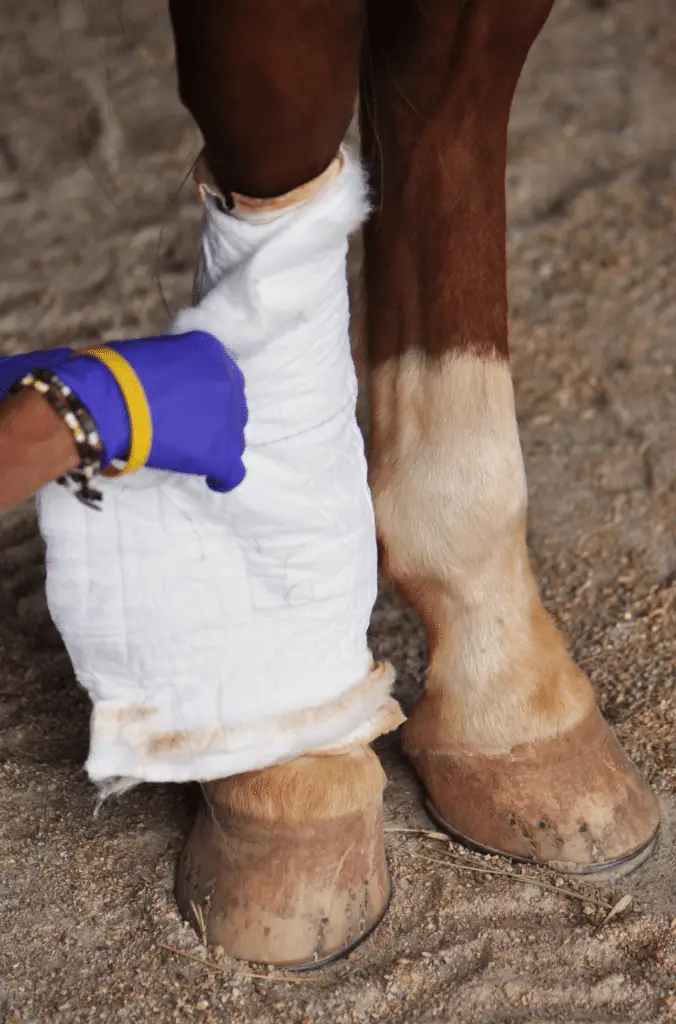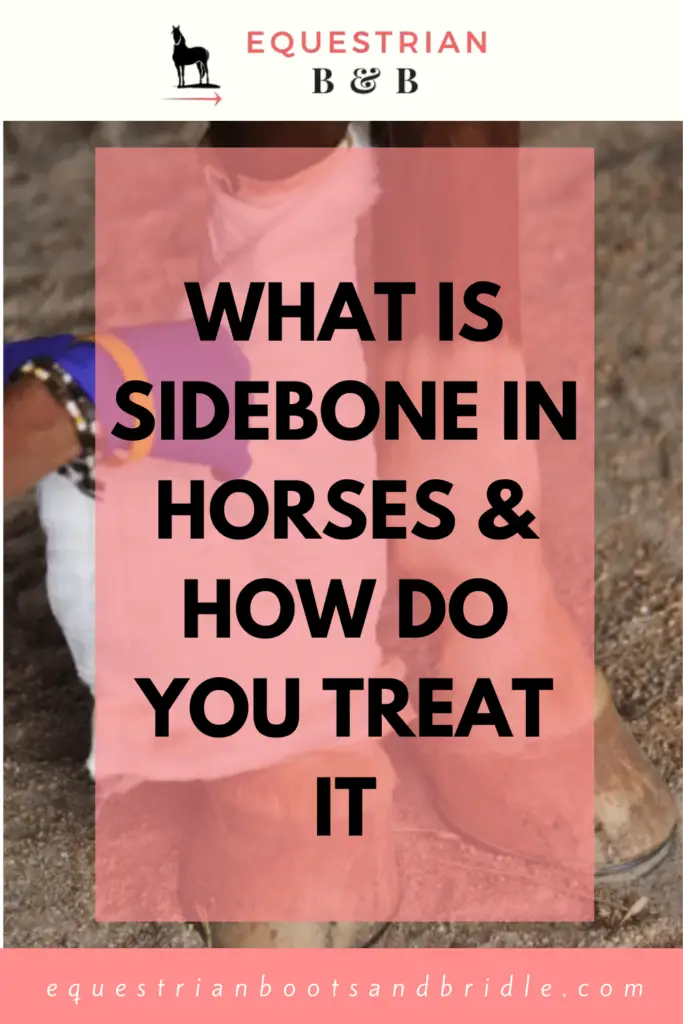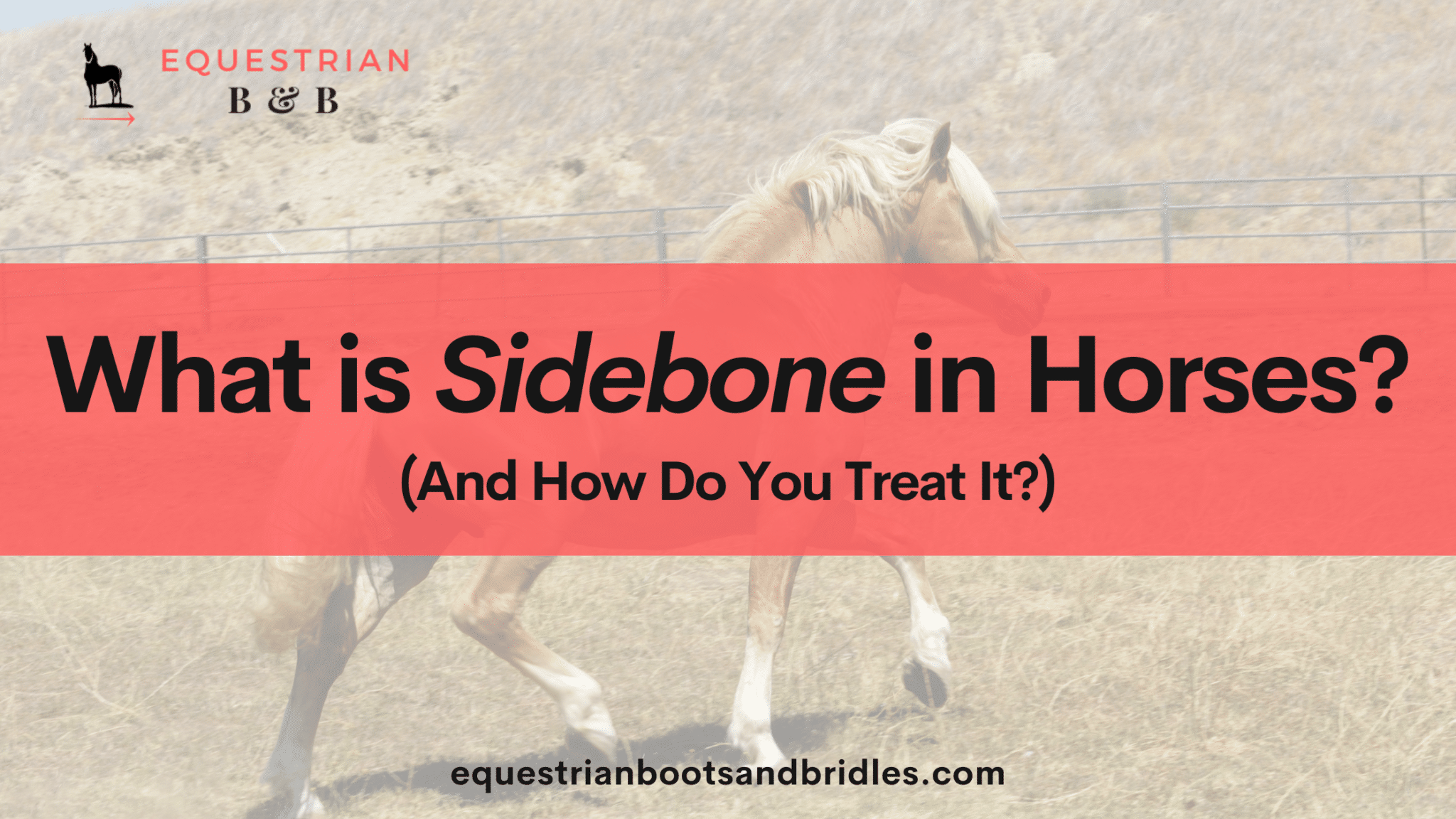For horse owners, especially those who have thoroughbreds straight off the track, a diagnosis of sidebone can be scary. Does it mean your horse (and your investment) has received a death sentence or is doomed to be a lawn-ornament since you’ll never be able to ride them again? Knowledge about sidebone will help ease your mind and inform you about what the future holds for you and your horse.
I’ve got the lowdown on sidebone in horses, what it is, how to treat it, and much more. Let’s dive in.
As always, the information in this article is for informational purposes only and should not be considered medical advice for your horse. You should always consult with your vet when treating your horse.
What Is Sidebone in Horses?
Sidebone, as the name suggests, is formation and change of bone on the sides of the horse’s pastern joint. The pastern bones become fused into a single immovable bone when the sidebone formation has run its course.
While there may be a slight reduction in stride length, most horses adapt well to sidebone once the formation has settled. During sidebone formation, it can be painful for the horse, and they may become lame as nerves interact with the bone formation.
Sidebone Vs Ringbone
While you may have heard of ringbone, and you probably know it’s a very dire diagnosis for the horse, sidebone rarely causes indefinite pain and lameness.
Ringbone may lead to the owner having no option other than to euthanize their horse when the horse is unable to bend their fetlock at all due to a solid boney ring around the joint.
Sidebone may develop on one side of the pastern joint, or it may develop on both sides, but as long as the two bony growths don’t lock up the movement of the fetlock or become excessively large, the horse can continue moving.
Signs of Sidebone in Horses
Most horse owners are quite unaware their horse has developed sidebone until a farrier points it out or the horse starts going lame. Lameness is usually due to direct trauma to the bone formation, which moves the existing sidebone. Or, lameness can also be due to the sensitive structures of the leg and foot responding to the formation of sidebone (during the formation process).
Here are a few signs to look out for when your horse starts developing sidebone:
1. Sudden Lameness
If your horse starts going lame with mild work or even comes in lame from the pasture, it may indicate discomfort caused by inflammation. Usually, inflammation accompanies sidebone formation until the calcified bone has fully solidified, which is when inflammation will lessen and cease.
Lameness that involves the forelegs is often an indication of ossification of the cartilage tissue in the lower legs—specifically the collateral cartilages of the sides of the horse’s feet and pastern area. When sidebone extends into the hoof capsule with the fusing of the actual hoof bones and the distal phalanx fuses, there may be severe lameness when there is increased swelling inside the inflexible hoof capsule.
2. Sudden Prancing
When a horse is restless on their feet, especially on the front feet, they may shift weight from one foot to the other. This is often caused by sensitivity in the lower joints due to calcification processes associated with sidebone. Standing on hard surfaces may worsen this shifting behavior, and they may seem stiff when asked to walk forward after a lengthy time standing in place.
3. Change of Stride
Some horses adapt to the formation of sidebone by changing their dominant stride leg to the less dominant (and unaffected) leg. The stride length may also decrease, and the horse may refuse to pick up canter leads on the affected limbs.
4. Pocket Formation on Sides of Hooves
Calcification will solidify the spongy cartilage tissue of the coronary band and surrounding tissues down the side of the horse’s foot. These calcified pockets will present as hard lumps when you palpitate the side of the horse’s hoof, just above the coronary band.
5. Swelling and Heat in the Lower Limb
In some cases when calcification is due to hard and repeated impact, the sidebone formation process may occur at speed, which may cause swelling and inflammation in the affected foot and lower limb. The swelling may be worse in horses that are stable bound or made to stand for long periods as the extra fluid produced by inflammation pools above the coronary band.

What Causes Sidebone in Horses?
There is no definitive explanation for the formation of sidebone and ringbone. What is known is that concussive impact and excessive work when the horse is young all contribute to calcification of the cartilage of the joints.
Concussion causes microfractures of the spongy cartilage. The horse’s body responds by healing these breaks in the cartilage with the deposit of extra calcium and an inflammatory response. The cartilage thickens where it heals, and as this process of break-heal-break repeats, sidebone is formed.
The actual cause of lameness can only be determined by a definitive diagnosis using x-rays to scan the horse’s limbs. A bone scan can also determine the extent of the sidebone, whether it’s likely to affect the hoof wall (for sidebone inside the hoof capsule) or if the sidebone is likely to be affected by external trauma. The information that these two diagnoses can offer will help you manage your horse’s sidebone formation and make informed decisions.
Sidebone may extend to become ringbone, but usually if the hardened calcified cartilage is focused lower on the sides of the foot bones, the process halts once the sidebone formation is complete. Continued hard work may act as a contributing factor in ringbone formation, so horse owners should take care to give their horse plenty of rest while sidebone is forming.
Horses prone to sidebone are heavier breeds that have larger joint capsules. Sidebone development is also more likely when heavy horses working on hard ground receive improper shoeing. Older horses develop sidebone when the lateral cartilage has fused into the tell-tale c-shaped cuff that may wrap around the sides of the horse’s hoof.
Carriage horses often develop sidebone, as can horses that are exposed to repeated concussive forces, such as from racing, jumping, and long distance riding. When the horse’s feet are exposed to repeated concussion on a hardened surface such as a dirt track, stone, paving, or road surfaces, the frequency of the breaking of cartilage increases, speeding up the development of sidebone.
Other factors that may also contribute to sidebone formation include:
- Conformation
Horses with poor limb conformation and odd-shaped hooves may be more prone to sidebone formation. Upright or boxed hooves may add to the pressure on the lower limbs, reducing the horse’s ability to handle hoof concussion.
- Foot Imbalance
If the horse’s hooves have received improper trimming and shoeing techniques that have caused the hooves to become imbalanced, it may negatively affect the hoof’s natural ability to disperse concussive forces. The result is lameness from improper blood flow in the hoof.
Treatment for Sidebone in Horses
To treat sidebone in horses, it’s important to first diagnose whether any lameness the horse has is from sidebone or from another cause. It’s dangerous to see a lump above the coronary band and assume that is the cause of the horse’s lameness. A specialist vet will obtain an x-ray and do nerve blocks to assess where the pain causing the lameness originates from.
If the sidebone is actively forming, the horse will benefit from rest and only mild walking as movement is required to maintain the mobility of the lower limb joints. Stall rest may be necessary if there are complications with the sidebone formation or if there’s nerve involvement.
Working with both your vet and specialist farrier, corrective trimming and shoeing may be needed to support the lower leg joints and ensure the hoof capsule is supported and cushioned from further excessive concussion.
If pain continues after the sidebone has settled, a specialist vet may recommend a neurectomy of the palmar digital nerves, which are nerves that register pain in the hoof. The nerves are surgically severed, meaning the horse’s hoof is numb to concussion and pain. This is a dangerous procedure and may preclude your horse from participating in some sports.
Supportive Treatment for Sidebone in Horses
When treating sidebone, it may become necessary to manage pain and inflammation while the sidebone is active and still developing. Your vet may place your horse on an anti-inflammatory medication such as Previcox with phenylbutazone being prescribed to manage the worst pain if needed.
To help reduce swelling from inflammation, you may use cold hosing, ice baths, and leg wraps with pillow wraps may help limit swelling and help contain inflammation. Care should be taken not to bind legs too tightly.
A specialist farrier may be able to shoe your horse with shock-absorbing pads to help reduce concussion on the affected hoof pairs. Regular trimming may be required to ensure the horse’s hooves remain balanced and don’t place extra pressure on any particular limb.
Regular monitoring by your vet will also be required to ensure no external trauma breaks apart the sidebone, which can cause bone fragments and bone spavin, resulting in complications and severe pain. If this happens, your horse may require surgery to remove the bone fragments.
Boost your horse with herbal anti-inflammatories and joint-healing medications like devil’s claw for inflammation, rosehip for joint healing, fish oil for omega oils and joint health, and collagen for boosting cartilage development.
Recovery and Continued Work Prognosis for Horses
Sidebone is a developmental condition that can go either way. If your horse continues with hard work where concussive forces are not managed, they may suffer further development of sidebone into the delicate structures of the inner hoof, and they may also develop ringbone. Long-term rest is non-negotiable, though this doesn’t mean box rest. A horse with sidebone requires gentle exercise and regular movement on soft surfaces (unless otherwise prescribed by the vet).
Once sidebone has sufficiently settled, a horse may return to moderate work if there is no lingering pain or inflammation. Care will have to be taken to avoid any undue concussive forces such as running on hard ground or jumping. However, your horse should be quite happy to hack, do ranch work, dressage, or participate in Western pleasure classes.

More FAQs About Sidebone in Horses
Can a horse recover from sidebone?
If diagnosed early and care is taken to minimize the impact of sidebone on the hoof health, shape, and mobility, a horse may make a recovery from sidebone. When inflammation is severe and the condition has gone unmonitored, the horse may not recover fully and may not be a ridden horse again.
Can horses with sidebone jump again?
A definitive answer depends on the location and condition of your horse’s sidebone, but horses with fully settled sidebone may be able to pop a few jumps. Competitive jumping may be too strenuous for a horse with sidebone.
Final Thoughts on Sidebone in Horses
When your horse starts going lame, your instinct is to check for ringbone, sidebone, or some other trauma. It’s wise not to jump to the worst conclusion without first consulting with your vet and having the necessary diagnostic tests done to confirm a diagnosis.
Your horse can live a full, pain-free, and ridden life if their sidebone formation is monitored and managed. Sidebone is not a condition the horse “grows out of.” Rest alone will not cure it, but rest is where your management program starts. Put your horse first and get them the help they need as you walk this long journey with them to recover and become comfortable again.
To read more about ringbone, check out my guide on ringbone.
Pin the image below to your boards on Pinterest.
You can also follow along with me on Pinterest!


